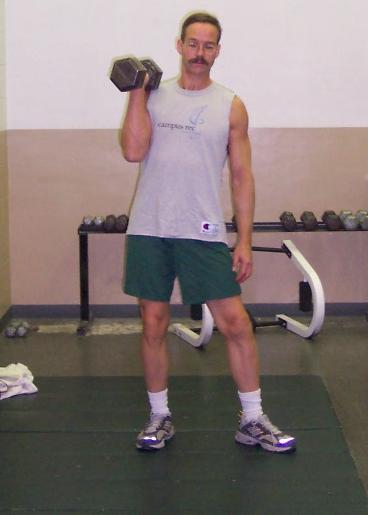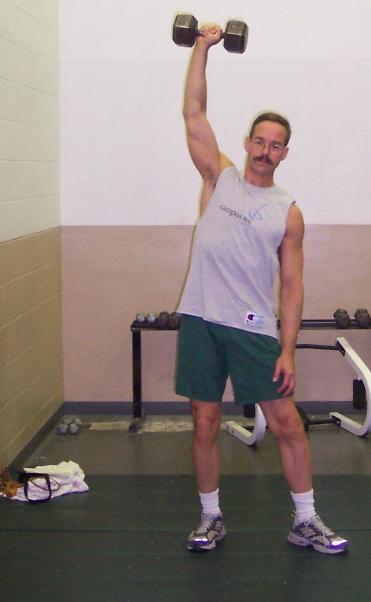Side press.
Description: There is a difference with
this one from the standard overhead press. An overhead press has you square
under the weight and very strongly isolates the deltoid. This has you slightly
turned. You should put your hip
under the weight so as to engage the lats. You can just use the
shoulder, but keep the weight in front of you.
Motions trained:Overhead pressing
Main muscles used: Lats and triceps on the way up, biceps and pecs
on the way down and all of it requires a very strong core. This is a total
body exercise. You get as much benefit from raising as lowering the weight.
Other muscles:Deltoids, upper back.
How to do it: Get the weight to your shoulder. It should be held
so that
your hip is under the weight and there is structure between the weight
and the floor.
Be sure your abs are tight and your tailbone is underneath you. The
usual weightlifter's overhead press has your shoulder in a bad position
since the
intent there is to have an isolation exercise. The thumb-side of your
hand is pointing to the rear initially and if you like, you can
rotate hand so your
thumb is pointing towards you at extension. This engages the anterior
deltoids too so you get all three heads of the deltoid working.
Flare or tighten your lats and push the weight straight
up, keeping it over your shoulder.
How to work up to it:
Start with no weight and get the hip under it, then
use lightweight dumbbells. Stand in a doorway and just do an
isometric exercise of trying to push on the door (tilt when you do it,
just as if you had a weight). The big limiting factor with this
exercise is usually not the shoulder , but core strength. A weak core
means your body won't let you complete a rep, so pushing on doors is
time well spent.
Ramping it up: Once you get it working, try blasting the weight
straight
up using your lats to power it. If you do it right, the weight will be
airborn at the
top and you will have to catch it then yank it down. This gives you the
plyometric version.
You can also add in a bicep curl too.
Do's and don'ts:
Under no conditions
lean back as you will possibily hurt your back. Make
sure your hip is truly under the
weight since when you start moving higher poundages you might suddenly
find yourself
off-balance.
Comments: A great exercise. Flaring the lats will make the
weight feel
really light and that, plus the root to the ground makes this a
functional exercise
rather than an isolation exercise for the deltoids. Oh, I normally
don't do double
overhead presses (both bells up at the same time) since my back does
not like it; it is not possible to get into the position correctly
doing it bilaterally.
Handstand pushups take the place of those.
One bit of information that has come to my attention recently is
from trainer Eric Cressy. he states
And, to be honest, I'm almost willing to say that adequate function
of the opposite hip and ankle is more important than the isolated
muscle strength of the rotator cuff.
which describes exactly what you are practicing if you do this right. His
context was for training athletes who require overhead motions (football,
tennis) and are very prone to shoulder problems. He wrote a book on this
but most recently has come to the opinion that scapular stabilizers and
thoracic mobility are much more important that the rotator cuff for shoulder work.
he goes on to give this little gem
100% of shoulder problems involve scapular dysfunction, but not all
shoulder problems involve rotator cuff weakness.
This version of the overhead press in conjunction with the opposing
pull up
works exactly what you need.
One last little comment. If you do this for higher poundages plus some
form of squatting lift (e.g. back squat) you have a complete powerlifting program
to help your strength. Good to know if you want to try some such program to pack
on muscle.



